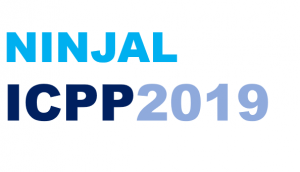HOME | IMPORTANT DATES | PROGRAM | CALL FOR PAPERS | REGISTRATION | FOR PRESENTERS | VENUE & MAPS | ACCOMMODATIONS | CONTACT


Download -> ICPP2019_Program_20191215.pdf
Please note that this program is subject to change. Last updated: December 9, 2019.
Day 0: THURSDAY, December 12, 2019
14:30-17:45 Pre-ICPP Workshop
Introduction to Pitch-accent Systems Around the World
18:00-19:00 COMPLIMENTARY WINE RECEPTION
Day 1: FRIDAY, December 13, 2019
9:30-10:00 REGISTRATION
10:00-10:05 OPENING
[Session 1] Investigating Syntax-Prosody in Optimality Theory (SPOT) Abstract
Chair: Shigeto Kawahara (Keio University)
10:05-10:25 Introduction: Why SPOT?
Junko Ito and Armin Mester (UC Santa Cruz)
10:25-11:05 SPOT App tutorial, demonstration, and Japanese case study
Jennifer Bellik and Nick Kalivoda (UC Santa Cruz)
11:05-11:20 Discussion
11:20-11:40 Italian case study: Recursive Phrasing
Nick Van Handel (UC Santa Cruz)
11:40-12:00 Chamorro case study: Pronoun Alignment
Richard Bibbs (UC Santa Cruz)
12:00-13:10 LUNCH
[Session 2] Interface (1) Chair: Manami Hirayama (Seikei University)
13:10-14:10 Issues in recursive prosody Abstract
Junko Ito and Armin Mester (UC Santa Cruz)
14:10-15:10 On the relation between syntactic and phonological clauses Abstract
Shinichiro Ishihara (Lund University)
15:10-15:20 BREAK
[Session 3]
15:20-16:40 Poster Session I
[Session 4] Interface (2) Chair: Mariko Sugahara (Doshisha University)
16:50-17:50 [Keynote] Constituency matches from spellout, mismatches from Phonology Abstract
Elisabeth Selkirk (University of Massachusetts Amherst)
18:00-20:00 BANQUET
Day 2: SATURDAY, December 14, 2019
[Session 5] Lexical Pitch Accent (1) Chair: Timothy Vance (Komatsu University)
10:00-11:00 [Keynote] On the location of pitch accents Abstract
Carlos Gussenhoven (Radboud University (NL) and NCTU (TW))
11:00-12:00 Two-peakedness in Scandinavian – evidence from South Swedish Abstract
Sara Myrberg (Lund University)
12:00-13:10 LUNCH
[Session 6]
13:10-14:30 Poster Session II
14:30-14:40 BREAK
[Session 7] Lexical Pitch Accent (2) Chair: Kiyoko Yoneyama (Daito Bunka University)
14:40-15:40 Lexical lack of accent and dephrasing in Northern Bizkaian Basque Abstract
Gorka Elordieta (University of the Basque Country) and Elisabeth Selkirk (University of Massachusetts Amherst)
15:40-16:40 Accent shift in Basque Abstract
José Hualde (University of Illinois)
16:40-17:00 BREAK
17:00-18:00 Tone and stress as agents of cross-dialectal variation: the case of Serbian Abstract
Draga Zec (Cornell University) and Elizabeth Zsiga (Georgetown University)
Day 3: SUNDAY, December 15, 2019
[Session 8] Lexical and Postlexical Prosody (1) Chair: Seunghun Lee (International Christian University)
10:00-11:00 Dialect-specific prosodic phrasing in Japanese: With a focus on dialects without lexical tone contrasts Abstract
Yosuke Igarashi (Hitotsubashi University)
11:00-12:00 Interactions between lexical and postlexical tones: Evidence from Japanese Abstract
Haruo Kubozono (NINJAL)
12:00-13:10 LUNCH
[Session 9] Lexical and Postlexical Prosody (2) Chair: Yuki Hirose (The University of Tokyo)
13:10-14:10 The interaction of tone and intonation in Uspanteko Abstract
Ryan Bennett (UC Santa Cruz)
14:10-15:10 [Keynote] Prosodic asymmetries in nominal vs. verbal phrases in Bantu Abstract
Larry Hyman (UC Berkeley)
15:10-15:15 CLOSING
Poster Session I: Friday, December 13, 2019 (15:20-16:40)
Click the title to read the abstract.
[1-1] Double accentuation system in modern French
Junkai Li (Sun Yat-sen University, Crem – Université de Lorraine), Xiao Chen (Guangzhou University)
[1-2] A Cross-dialectal investigation of prosody of Mandarin ritual and sincere refusals: Cues and detectability
Yufen Chang (Western Kentucky University), Yunwen Su (University of Utah)
[1-3] Word stress or a foot-phrasal prominence interaction in Estonian?
Natalia Kuznetsova (University of Turin / Institute for Linguistic Studies, Russian Academy of Sciences)
[1-4] Assessing tonal specifications on a token-by-token basis
Shigeto Kawahara (Keio University), Jason Shaw (Yale University), Ishihara Shinichiro (Lund University)
[1-5] Variation in Mainland Scandinavian Object Shift: A prosodic analysis
Nomi Erteschik-Shir (Ben-Gurion University), Gunlög Josefsson (Lund University),
Björn Köhnlein (Ohio State University)
[1-6] Givenness and stress rejection in Optimality Theory
Fabian Schubö (University of Stuttgart)
[1-7] The domain of pre-boundary lengthening in German
Sabine Zerbian, Fabian Schubö (University of Stuttgart)
[1-8] A sound symbolic analysis of the monster names of Monster Hunter
Hiromu Tanji, Gakuji Kumagai (Meikai University)
[1-9] The sound-symbolic effect of voiced obstruents on the spell names of Final Fantasy
Takuya Matsuhashi, Gakuji Kumagai (Meikai University)
[1-10] How is evolution expressed sound-symbolically? An analysis of the monster names of Digital Monster
Kazuaki Yoshitake, Gakuji Kumagai (Meikai University)
[1-11] Effect of language dominance on focus prosody: Evidence from Wu-Mandarin bilinguals
Wenxi Fei, Mingyu Weng, Albert Lee (The Education University of Hong Kong)
[1-12] Control of speech timing in Korean: Durations of vowels in/after closed and open syllables
Shoji Ishibashi, Shonosuke Koya, Hajime Takeyasu (Fukuoka University)
[1-13] Vowel classification using machine learning: Random forest analysis
Daiki Hashimoto (The University of Tokyo)
[1-14] Prosodic cues of polar questions in Drenjongke (Bhutia)
Seunghun J. Lee (International Christian University, University of Venda),
Céleste Guillemot (International Christian University),
Kunzang Namgyal (Nar Bhandari Degree College),
Jigmee Wangchuk Bhutia (Enchey Senior Secondary School)
[1-15] Hierarchy of special morae in Japanese: Evidence from loanword compound truncation
Changyun Moon (University of Tsukuba)
[1-16] Recursivity and the definition of MATCH in Italian syntax-prosody
Nicholas Van Handel (UC Santa Cruz)
[1-17] Prosody and morphosyntax in Basque and Japanese
Hisao Tokizaki (Sapporo University)
[1-18] A binarity binarity: Branch-counting vs. leaf-counting
Jennifer Bellik, Nick Kalivoda, Nick Van Handel (UC Santa Cruz)
[1-19] Prosody comes first? Phonetic realization of long vowels in Drenjongke
Céleste Guillemot (International Christian University),
Tomoko Monou (International Christian University),
Shigeto Kawahara (Keio University),
Seunghun J. Lee (International Christian University, University of Venda)
[1-20] Danish, Estonian, English: Variations on a theme
Markus A. Pöchtrager (University of Vienna)
[1-21] On the voiced obstruent geminates in the Owase dialect (Mie Prefecture, Japan)
Shu Hirata (NINJAL)
[1-22] Deriving accent from structure: The case of Japanese verbs
Thomas Schökler (University of Vienna)
[1-23] Prosodic alignment of weak pronouns in Chamorro
Richard Bibbs (UC Santa Cruz)
Poster Session II: Saturday, December 14, 2019 (13:10-14:30)
Click the title to read the abstract.
[2-1] From the learnability of tonal dissimilation to the representation of contour tones
Tsung-Ying Chen (National Tsing Hua University)
[2-2] Arab learners’ problem in correctly producing words with “ate”
Safi Eldeen Alzi’abi (Damascus University) – cancelled
[2-3] Revisiting tone three sandhi acquisition: Insights from acoustical analysis
Chin-Ting Liu (R.O.C. Naval Academy)
[2-4] The sound symbolic value of Japanese lexical pitch accent: A case study of baby diaper names
Gakuji Kumagai (Meikai University), Shigeto Kawahara (Keio University)
[2-5] Predictive synthesis of Japanese word prosody using AMtrainer
Albert Lee (The Education University of Hong Kong), Yi Xu (University College London)
[2-6] Acoustic analysis of tone sandhi in Northern Sixian Hakka
Hsiu-Min Yu (Chung Hua University), Wen-Jun Huang (National Central University)
[2-7] The perception of Japanese pitch accent and segmental contrasts by L2 learners
Marco Fonseca (University of Illinois)
[2-8] Apophonic compounds: new evidence for prosodic word binarity in Japanese
Maëlys Salingre (The University of Tokyo)
[2-9] Longyou (Wu) tones and tone sandhi
Michael Kenstowicz, Sherry Yong Chen (MIT) – cancelled
[2-10] Perceptual boundaries of Mandarin tones: Level vs. rising and level vs. falling
Wu Qi, Zhu Chunyue (Kobe University)
[2-11] Interviewer effects on speech production in Cantonese: A pilot study
Mingyu Weng, Wenxi Fei, Albert Lee (The Education University of Hong Kong)
[2-12] The effect of lexical pitch accent and downstep on listeners’ word identification in Japanese
Yukiko Sugiyama (Keio University), C. T. Justine Hui (Sophia University), Takayuki Arai (Sophia University)
[2-13] The interaction between phonological neighborhood density, lexical status, and lexical competitors on production of Italian stops
Concu Valentina, Bruno Staszkiewicz Garcia (Purdue University)
[2-14] The Bantu-like tonal characteristics of Tarama (Miyako, Ryukyuan)
Hayato Aoi (ILCAA/NINJAL)
[2-15] The paradox between phonological variety and optionality
Kohei Nishimura (Iryo Sosei University)
[2-16] Morpho-syntactic and prosodic effects on Taiwanese Min sandhi and base tones
Ho-hsien Pan, Hsiao-tung Huang (National Chiao Tung University)
[2-17] Constraint induction in the historical development of initial accent in Kyoto Japanese trimoraic nouns
Andrew Angeles (UC Santa Cruz)
[2-18] Gender construction and fundamental frequencies in Japanese
Maho Morimoto, Shigeko Okamoto (UC Santa Cruz)
[2-19] Bilingual lexicon of phonologically different languages and similar languages
Sanae Matsui, Mafuyu Kitahara (Sophia University)
[2-20] Lexical accent in Lithuanian: Is tone enough?
Anton Kukhto (MIT)
[2-21] Asymmetric prominence of correlates of wh-words in San Martín Peras Mixtec
Andrew Hedding (UC Santa Cruz)
[2-22] Categorization of Cantonese lexical tones by Japanese-speaking novice listeners and learners of Chinese Mandarin
Wong Yee Ping (Sophia University)
![]()
![]()


NINJAL ICPP 2019 is jointly organized by NINJAL’s collaborative research project “Cross-Linguistic Studies of Japanese Prosody and Grammar” and by UCSC’s grant on SPOT (Syntax-Prosody in OT), supported by JSPS KAKENHI grant to NINJAL and NSF grant to UCSC.